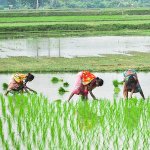Nuakhai – Harvest Festival in Odisha Date in the current year: August 28, 2026
 Nuakhai is a traditional harvest festival observed in the Indian state of Odisha (mainly in its western part). It occurs on the day after Ganesh Chaturthi, a major Hindu festival celebrating the deity Ganesh. In the Gregorian calendar, the date Nuakhai falls during August or September.
Nuakhai is a traditional harvest festival observed in the Indian state of Odisha (mainly in its western part). It occurs on the day after Ganesh Chaturthi, a major Hindu festival celebrating the deity Ganesh. In the Gregorian calendar, the date Nuakhai falls during August or September.The name of the festival, which is also called Nuakhai Bhetghat or Nuakhai Parab, consists of two words: nua, meaning new, and khai, meaning food. Therefore, it literally translates as “new food”, which is a reference to the newly harvested rice that is offered to the gods at the beginning of the harvest season.
Although today Nuakhai is celebrated throughout the state of Odisha, it is particularly important in the life and culture of people of Western Odisha. The biggest celebrations take place in the districts of Balangir, Bargarh, Boudh, Jharsuguda, Kalahandi, Nuapada, Sambalpur, Sonepur, and Sundargarh.
According to research, Nuakhai is one of Odisha’s most ancient festivals. Some researchers believe that its roots can be traced back to the Vedic period (circa 1500 – 500 BCE), when the sages (rishis) singled out five important stages in the annual rice growing cycle: the tilling of the land (sitayajna), the sowing of seeds (pravapana yajna), the initial cutting of crops (pralambana yajna), the harvesting of grains (khala yajna), and the storing of grains (prayayana yajna). The Nuakhai festival is most likely to have evolved from pralambana yajna, which involves offering the first crop to the gods to appease them.
However, the ancient origin of Nuakhai is only an assumption. The oral tradition dates it back to the 12th century and the foundation of the princely state of Patma, which is currently part of Balangir district of Odisha. Raja Ramai Deo, the founder and first ruler of Patna, realized that settled agriculture was indispensable to the formation of an independent kingdom because hunting and food gathering couldn’t generate the surplus required to maintain economical stability of a state. During the formation of Patma, Raja Ramai Deo used Nuakhai to promote agriculture.
In the early years, the harvest festival didn’t have a fixed date. It was held sometime during the lunar fortnight of the Hindu month of Bhadra, when autumn crops – rice in particular – began to ripen. Even though the grain was not ready for harvesting yet, farmers would cut some of it before any animals or birds had a chance to peck on it and presented the crop to the reigning deity of their village or area. The date was chosen in each village by the local priest and village head.
Eventually, Nuakhai has become a common festival celebrated all over Odisha and got a fixed date, the fifth day of the lunar fortnight of Bhadra (the next day after the Ganesh Chathurthi festival). In 1991, the government of Odisha declared the Nuakhai festival an official holiday.
To celebrate Nuakhai, people give offerings to the deities both at temples and at their domestic altars. Many of the festival traditions are similar to that of other Hindu festivals, for example, wearing new clothes, exchanging greetings with one’s friends and family, offering regards to one’s elders, singing, dancing, feasting, etc.
* date for 2025
- Category
- Folk Festivals
- Country
- India
- Tags
- Nuakhai, harvest festival, folk festival, traditional festival, Hindu festival, festivals in India, festivals in Odisha